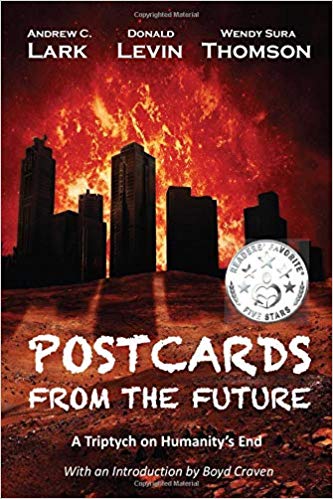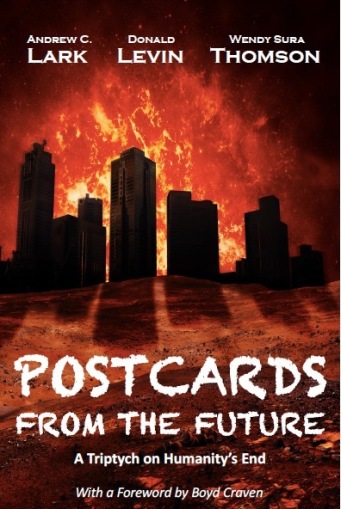Last week I did an interview with Jeff Milo from the Ferndale Area District Library for his new podcast, “A Little Too Quiet.” We had a relaxed and wide-ranging conversation, including taking about my writing and background. As you might expect, we spent some time talking about my series of mysteries, the Martin Preuss mysteries, set in and around Ferndale.
As I write this, the show is scheduled for the end of February 2020. You can listen to all the episodes of the podcast here: https://alittletooquiet.podbean.com/. Jeff’s conversations with other local authors (including Josh Malerman, Kathe Koja, and Michael Zadoorian) are thought-provoking and enjoyable.
Jeff and I also talked about my more recent writing. The last pieces I’ve published have been in a different genre from the mystery novels: they are a pair of dystopian novellas. One, “The Bright and Darkened Lands of the Earth,” appears in an anthology, Postcards from the Future: A Triptych on Humanity’s End (Quitt and Quinn Publishers and Whistlebox Press, 2019) along with the works of two other fine writers, Wendy Sura Thomson and Andrew Lark.
My other novella is a stand-alone sequel to “The Bright and Darkened etc.” published separately as The Exile (Poison Toe Press, 2020).
Writing dystopian fiction—or really post-apocalyptic fiction, as my two recent works are—turned out to be more taxing than I thought it would be.
I have to admit, at first it was fun.
I had published six Preuss mystery novels in a row from 2011 to 2019, and I felt like I was getting stale. I thought turning to dystopian fiction last year in response to an invitation from Andrew Lark (who spearheaded the Postcards project) would be a good change. It would let me take a break from mysteries, and indulge one of my long-time pleasures, post-apocalyptic fiction and films.
After I wrote the first novella, I had an experience that I’ve never had before, even with the Preuss series . . . an entire world sprang up in my brain as I thought about the characters, their situations, and their world, and I could see possibilities for continuing to write about them in several more novellas. My plan evolved into writing The Exile and maybe two or three more installments set in that world, and then combine them all into one large work.
I took to thinking about the different pieces as part of The Dry Earth Series—so called because the action takes place in a world devastated by climate catastrophes.
And here’s where it starts to get depressing.
I think of these novellas as “speculative fiction,” to use the term that Margaret Atwood uses: fiction that begins with current conditions, and then engages in a kind of thought experiment to project forward in order to imagine how things might turn out, given where we are starting from. She’s a master of it in works like The Handmaid’s Tale, Oryx and Crake, and most recently The Testaments.
Several current trends came together in “The Bright and Darkened Lands of the Earth—not only the climate disasters that we are starting to see already (vide Australia burning), but also emerging global pandemics (vide the coronavirus), the breakdown of our lawful democratic system and the failure of the American experiment (vide your news today), looming failures in agriculture leading to widespread famine (vide Monsanto’s latest annual report) . . . all of these converged to create the nightmarish hellscape of “The Bright and Darkened Lands of the Earth.”
And I continued to explore their impacts in The Exile.
And not by simply discussing the problems themselves, of course, but rather by showing their devastating effects on the desperate lives of individual characters.
Without getting into spoilers, it’s not a pretty picture.
The more I wrote about the world of the Dry Earth Series, the more all the problems I was writing about—climate devastation, cultural suicide enacted daily in the political sphere, an uninhabitable earth, mass extinctions of plants and animals, violence released into the air along with lingering radiation—began to seem so possible.
Even, unfortunately, so likely.
As this country seems to be embracing its own apparently inexorable dystopian future, thinking seriously about the kinds of nightmares the future holds became more and more difficult and disheartening for me.
My mental state, already reeling and fragile from the corruption and mean-spirited, willful stupidity spewing nonstop out of Washington, began to decline even further.
I decided I need a break from my break.
The solution was simple: for my next project, I’m going to return to the world of Martin Preuss and his son Toby.
After I finished “The Bright and Darkened Lands of the Earth” and sent it off to the editor, I launched into the seventh Preuss book and finished about 13,000 words on the draft. I stopped when the novella came back from the editor, and then I found one of the characters in the novella to be so compelling that I began another manuscript that turned into The Exile.
Talking to Jeff Milo about the Preuss series made me realize how much I missed the characters of Martin Preuss and most especially Toby.
Toby, who brings so much light into his fictional father’s life, does the same for me. Profoundly handicapped, he is an accurate and loving portrait of my grandson Jamie. Toby is a source of enormous comfort, joy, and wisdom for his father, as Jamie was for those of us who knew and loved him.

Regretfully, Jamie is no longer with us. But while we were privileged to have him, Jamie taught us so much about love, patience, the necessity for presence in one’s life, and what is really important in a world that seems crazier and more out-of-control by the day.
Writing about Toby, and showing how sweet and loving he is and how important he is in his father’s life (and, indeed, the lives of everyone he touches), gives me the chance to celebrate his great gifts, and by extension the gifts of all the children and people like Toby and Jamie.
We need that now, more than ever.
So that’s what’s next for me. I’m shelving the harsh, nightmarish, disintegrating world of the Dry Earth Series, and returning to the world of Martin and Toby—which is harsh and nightmarish in its own way, but at least tends toward order and social reintegration. Crimes are solved, mysteries are cleared up, criminals are held accountable.
And at the end of each day, a regenerating visit with his dear Toby always awaits investigator Martin Preuss.
My sabbatical from dystopian fiction might turn into a “Mondical and a Tuesdical,” as folksinger Lee Hayes said about The Weavers’ enforced break from music during the McCarthy hearings in the 1950s. Right now it’s hard to tell.
Regardless, look for the next entry in the Martin Preuss series in the fall of 2020. I can’t give out any details of the plot just yet—except to say that due to overwhelming demand from my readers, Martin Preuss may—just may—finally get a girlfriend.
Stay tuned.
In the meantime, when you have a chance, please have a listen to Jeff Milo’s podcast at https://alittletooquiet.podbean.com/.



 I’m releasing a new book this week . . . a novella, The Exile (Poison Toe Press).
I’m releasing a new book this week . . . a novella, The Exile (Poison Toe Press). If you’ve been following my posts, you know this book consists of three novellas that each offer a different, imaginative take on how humanity ends. They are dystopian visions, but ones that reviewers have described as “unique,” “beautiful,” and “well imagined,” and the book itself as “impossible to put down.”
If you’ve been following my posts, you know this book consists of three novellas that each offer a different, imaginative take on how humanity ends. They are dystopian visions, but ones that reviewers have described as “unique,” “beautiful,” and “well imagined,” and the book itself as “impossible to put down.”
 Guests enjoyed an excellent spread of food on a buffet organized by Wendy, Karen Lark, and Suzanne Allen. Adding to the atmosphere were musicians Bradley Stern on sax and Takashi Iio on upright bass; their mellow jazz put everyone in the right mood for good conversation.
Guests enjoyed an excellent spread of food on a buffet organized by Wendy, Karen Lark, and Suzanne Allen. Adding to the atmosphere were musicians Bradley Stern on sax and Takashi Iio on upright bass; their mellow jazz put everyone in the right mood for good conversation.














